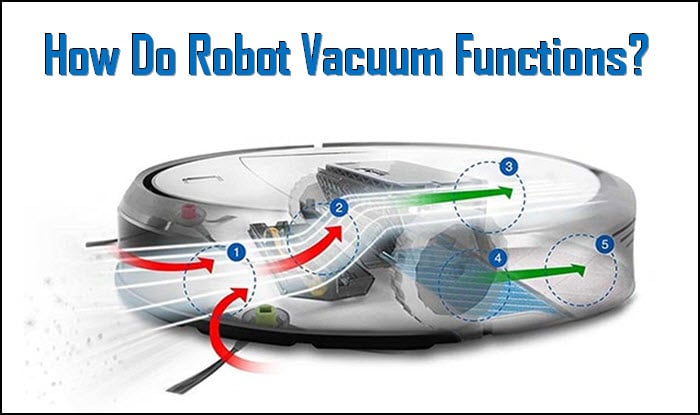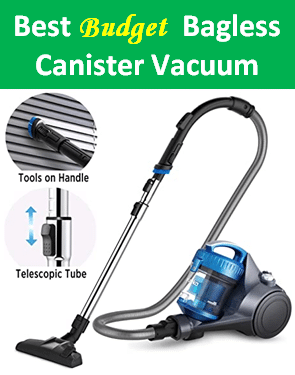Last updated on August 29th, 2022
Do you know that the robot vacuums have been in the market for about 20 years and these little auto-helpers is getting more and more popular?
This can be attributed to two main factors, affordability and functionality. Read on if you want to dig into just how these robot vacuums works.
Plenty of gimmicks and short-lived fads have come and gone over the years. Yet robot vacuums have avoided becoming one by providing a great service for their owners. They eliminate work.
But hold on just a second. Didn’t The Clapper eliminate work? This incredibly popular gadget eliminated the need to get up to turn lights on and off? Well, the answer is yes. Yes, it did.

Also read: How do Robot Vacuums Work?
How Robot Vacuum Cleaner Functions? – The Nuts and Bolts
Robot vacuums are designed with the same five or six mechanisms. These include the wheels and motors, vacuum assembly and brushes, navigation sensors, dustbin with filters, and the power supply.
1.) The Robot Vacuums - Wheels and Motors
These parts probably don’t need much of a description. Robot vacuums move around on two large wheels on each side with a nose wheel in the front. The right and left wheels have their own small motors that move the vacuum. They receive signals from sensors that tell them how to move. The more advanced the robot, the more advanced the movements.
The size and durability of the wheels determine what types of flooring the robot can cross safely. Small plastic wheels may work fine on bare floors but thicker carpets need larger wheels with treads to grip and pull the robot vacuum forward.
The higher the wheels the greater the clearance and ability to climb over the edges on thick rugs and floor dividers. Some models even have self-adjusting wheels that keep the vacuum in close contact with the floor, regardless of the floor type, for maximum vacuuming performance.
2.) The Robotic Vacuums – Vacuum Assembly
The vacuum doesn’t need much of an explanation either. It’s not much different than those in upright vacuums.
The fan sucks in dirt and debris while the primary brush agitates and loosens it on the floor. From there it gets sucked into the dustbin in the back. Pretty standard vacuum stuff.
The vacuum is certainly the heaviest part of a unit and by far the loudest. But there really isn’t a big variation in vacuuming strength among different models. The higher priced units will use terms like “efficiency” and “3x the power” and “turbo” but most maintain the same relative suction strength at around 1000 Pascals.
In fact, they’re about as good as they’re going to get until someone like the next James Dyson comes along and creates a better technology.
The biggest variations in performance are from the brush styles and the air flow from the mouth of the vacuum to the dustbin in the back. If you’ve ever had a vacuum where, as soon as you turn it off, a bunch of dirt drops out of the suction chamber back onto the carpet, you’ll understand what I’m talking about.
That and the ability to dig down into carpet to agitate dirt and having a focused suction that doesn’t just blow dirt around are also very important in performance.
3.) The Robot Vacuums - Brushes
Most models go with a Double-V style bristle brush for the heavy cleaning. This style seems to do a better job at scooping and agitating debris than helix brushes. Usually, you will find 3 types of brushes:
- Helix Brush
- Double V Brush
- Roomba Twin Extractors
The iRobot Roombas, on the other hand, use twin extractor brushes that are bristle free and help reduce tangles. They spin inward toward each other like a printing press, catching any pet hair and debris they come into contact with.
In addition to main brushes, most robot vacuums also come with at least one spinning side brush for grabbing dust along walls and other vertical surfaces. These are normally positioned up front and fling dirt backward into the main brush.
4.) The Robot Vacuums – Navigation Sensors
Almost all vacuums have standard sensors including drop sensors, proximity sensors, and optical encoders.
Drop Sensors – These sit near the nose wheel in the front and bounce infrared light at the floor. When it takes longer than normal for the light to bounce back to the receptor then it decides that there’s a drop off and will normally direct the robot vacuum to turn away.
Proximity Sensors – Also knows as Wall Sensors they do the same as Drop Sensors but in reverse. When the light bounces back sooner than normal it determines that there is an object in that direction and, depending on how smart it is and what mode it’s on, decides what to do next.
Optical Encoders – Sort of like a yard measuring wheel, the Optical Encoders (Rotary Encoders) measure the number of rotations the wheels make in order to get an idea of the distance the bot has travelled.
Apart from these standard sensors, most new innovations for robot vacuums are coming from mapping and smart features.
One of the newest technologies include robot vacuums with cameras that take digital photos to map the layout of rooms. These bots can start a methodical cleaning session, return to its dock to charge, and then go back and resume where it left off.
Robot vacuums like these are meticulous and efficient and are getting closer with every new model to replacing the upright vacuum altogether. They also come with a hefty price tag at several hundred dollars minimum.
5.) The Robotic Vacuums – Dustbin and Filters
The dustbins do the dirty work of trapping all of your household’s daily dirt a debris. They can be anywhere in size from around a 12 oz soda can to nearly twice that large.
Most are very simple to empty but of course the smaller the size the more emptying there will be to do.
Typically all dustbins use HEPA or HEPA-style filters to keep things like pet dander and allergens from circulating back into your home’s air where sensitive noses are living.
6.) The Robot Vacuums – Battery Power
Finally, none of this could be possible without some battery power. Maybe one day robot vacuums will work from solar power but for now they use rechargeable lithium-ion batteries mostly.
The length of cleaning sessions can vary from bot to bot, lasting anywhere from 45 minutes to 2 hours. Much of this depends on the size of the battery, the weight and strength of the vacuum, and the floor types that need to be cleaned.
Most robot vacuums will also return to dock and charge on their own when the battery gets low but their accuracy can vary greatly among models.
The Recommended Robotic Models
Robot vacuums from companies like iRobot were, and still are, at the cutting edge of robot vacuum technology. But for most, the $600 plus investment is just too much when you have a broom and traditional vacuums like canister vacuum, already paid for, in the closet.
Anyway, we pick the Roomba 981 model as the best overall robot vacuum has their solid reasons behind it! You can enjoy the company latest technology at reasonable price to help you clean your entire home effortlessly.
Also, some manufacturers are designing into the budget consumer marketplace. The Ecovacs Deebot N79s describes how this robot vacuum is joining the best of both worlds. It is a perfect example of how affordability and functionality combine to hit a price to performance sweet spot for consumers. It not only provides good cleaning performance, a service to the owner, but also ease of use with smart phone control. All with an affordable price tag.
Last but not least, check out the current best seller model at Amazon.com.
Last Word
Robot vacuums appear to be here to stay and are well intended to take some of the burden of everyday cleaning off our hands. Their success will most certainly lead to other cleaning robotics like mops, window cleaners, tub cleaners, lawn robots and who knows what else.
These little helpers are quickly becoming a staple for homes. More and more people are venturing into home robotic ownership and realizing that the positive impact they make is worth the investment.

